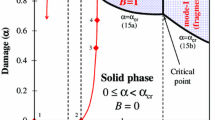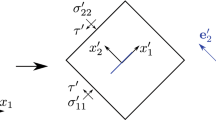Abstract
A model is developed for mechanical behavior and failure of brittle solids of geologic origin. Mechanisms considered include elastic stretch and rotation, thermal expansion, and deformation associated with micro-cracks. Decohesion on preferred cleavage planes in the solid, and subsequent effects of crack opening and sliding, are modeled. Explicit volume averaging over an element of material containing displacement discontinuities, in conjunction with the generalized divergence theorem, leads to an additive decomposition of the deformation gradient into contributions from thermoelasticity in the intact material and displacement jumps across micro-cracks. This additive decomposition is converted into a multiplicative decomposition, and the inelastic velocity gradient is then derived in terms of rates of crack extension, opening, and sliding on discrete planes in the microstructure. Elastic nonlinearity at high pressures, elastic moduli degradation from micro-cracking, dilatancy, pressure- and strain rate-sensitive yield, and energy dissipation from crack growth and sliding are formally addressed. Densities of micro-cracks are treated as internal state variables affecting the free energy of the solid. The mean fragment size of particles of failed material arises from geometric arguments in terms of the evolving average crack radius and crack density, with smaller fragments favored at higher loading rates. The model is applied to study granite, a hard polycrystalline rock, under various loading regimes. Dynamic stress–strain behavior and mean fragment sizes of failed material are realistically modeled. Possible inelastic anisotropy can be described naturally via prescription of cleavage planes of varying strengths.
Similar content being viewed by others
References
Ai HA, Ahrens TJ (2006) Simulation of dynamic response of granite: a numerical approach of shock-induced damage beneath impact craters. Int J Impact Eng 33: 1–10
Almeida LCR, Vargas EA, Figueiredo RP (2006) Mechanical characterization of rock-splitting planes in granitic rocks. Int J Rock Mech Mining Sci 43: 1139–1145
Amaral PM, Rosa LG, Fernandes JC (1999) Fracture toughness of different types of granite. Int J Rock Mech Mining Sci 36: 839–842
Amitrano D (2006) Rupture by damage accumulation in rocks. Int J Fract 139: 369–381
Andrade JE, Baker JW, Ellison KC (2008) Random porosity fields and their influence on the stability of granular media. Int J Numer Anal Meth Geomech 32: 1147–1172
Asaro RJ (1983) Crystal plasticity. ASME J Appl Mech 50: 921–934
Astrom JA (2007) Statistical analysis of shear cracks on rock surfaces. Eur Phys J B 56: 291–295
Bazant ZP, Caner FC, Carol I, Adley MD, Akers SA (2000a) Microplane model M4 for concrete. I: formulation with work-conjugate deviatoric stress. ASCE J Eng Mech 126: 944–953
Bazant ZP, Adley MD, Caner FC, Carol I, Jirasek M, Akers SA (2000b) Large strain generalization of microplane model for concrete and application. ASCE J Eng Mech 126: 971–980
Brace WF (1978) Volume changes during fracture and frictional sliding: a review. Pure Appl Geophys 116: 603–614
Brace WF, Paulding BW, Scholz C (1966) Dilatancy in the fracture of crystalline rocks. J Geophys Res 71: 3939–3953
Budianski B, O’Connell RJ (1976) Elastic moduli of a cracked solid. Int J Solids Struct 12: 81–97
Christensen RJ, Swanson SR, Brown WS (1974) Torsional shear measurements of the frictional properties of Westerly granite. Defense Nuclear Agency Report AD-787-043, Washington, DC
Clayton JD (2005a) Dynamic plasticity and fracture in high density polycrystals: constitutive modeling and numerical simulation. J Mech Phys Solids 53: 261–301
Clayton JD (2005b) Modeling dynamic plasticity and spall fracture in high density polycrystalline alloys. Int J Solids Struct 42: 4613–4640
Clayton JD (2006) Continuum multiscale modeling of finite deformation plasticity and anisotropic damage in polycrystals. Theo Appl Fract Mech 45: 163–185
Clayton JD (2008) A model for deformation and fragmentation in crushable brittle solids. Int J Impact Eng 35: 269–289
Clayton JD, McDowell DL (2003) Finite polycrystalline elastoplasticity and damage: multiscale kinematics. Int J Solids Struct 40: 5669–5688
Clayton JD, McDowell DL (2004) Homogenized finite elastoplasticity and damage: theory and computations. Mech Mater 36: 799–824
Coleman BD, Gurtin ME (1967) Thermodynamics with internal state variables. J Chem Phys 17: 597–613
Eckart C (1948) The thermodynamics of irreversible processes IV. The theory of elasticity and anelasticity. Phys Rev 73: 373–382
Englman R, Rivier N, Jaeger Z (1987) Fragment size distribution in disintegration by maximum entropy formalism. Phil Mag B 56: 751–769
Eringen AC (1962) Nonlinear theory of continuous media. McGraw-Hill, New York
Eshelby JD (1973) Dislocation theory for geophysical applications. Phil Trans R Soc Lond A 274: 331–338
Espinosa HD, Zavattieri PD, Dwivedi SK (1998) A finite deformation continuum discrete model for the description of fragmentation and damage in brittle materials. J Mech Phys Solids 46: 1909–1942
Foster CD, Borja RI, Regueiro RA (2007) Embedded strong discontinuity finite elements for fractured geomaterials with variable friction. Int J Numer Meth Eng 72: 549–581
Furnish MD (1995) Measuring the dynamic compression and release behavior of rocks associated with HYDROPLUS (Part II). Sandia Report SAND95-1472, Albuquerque, NM
Golshani A, Okui Y, Oda M, Takemura T (2006) A micromechanical model for brittle failure of rock and its relation to crack growth observed in triaxial compression tests of granite. Mech Mater 38: 287–303
Goodman RE (1989) Rock mechanics, 2nd edn. Wiley, New York
Grady DE (1982) Local inertial effects in dynamic fragmentation. J Appl Phys 53: 322–325
Grady DE (1988) The spall strength of condensed matter. J Mech Phys Solids 36: 353–384
Grady DE (1995) Shock equation of state properties of concrete. Sandia Report SAND95-2215C, Albuquerque, NM
Grady DE, Winfree NA (2001) Impact fragmentation of high-velocity compact projectiles on thin plates: a physical and statistical characterization of fragment debris. Int J Impact Eng 26: 249–262
He H, Jin X, Jing F, Ahrens TJ (1996) Characteristic of dynamic tensile fracture in augite-peridotite. In: Schmidt SC, Tao WC(eds) Shock compression of condensed matter. AIP Press, New York, pp 593–596
Hill R (1972) On constitutive macro-variables for heterogeneous solids at finite strain. Proc R Soc A 326: 131–147
Horii H, Nemat-Nasser S (1985) Compression-induced microcrack growth in brittle solids: axial splitting and shear failure. J Geophys Res 90: 3105–3125
Holcomb DJ (1978) A quantitative model of dilatancy in dry rock and its application to Westerly granite. J Geophys Res 83: 4941–4950
Ichikawa Y, Kawamura K, Uesugi K, Seo YS, Fujii N (2001) Micro- and macrobehavior of granitic rock: observations and viscoelastic homogenization analysis. Comp Meth Appl Mech Eng 191: 47–72
Imam A, Johnson GC (1998) Decomposition of the deformation gradient in thermoelasticity. ASME J Appl Mech 65: 362–366
Johnson GR, Holmquist TJ (1999) Response of boron carbide subjected to large strains, high strain rates, and high pressures. J Appl Phys 85: 8060–8073
Kingsbury SJ, Tsembelis K, Proud WG (2004) The dynamic properties of the Atlanta Stone Mountain granite. In: Furnish MD, Gupta YM, Forbes JW(eds) Shock compression of condensed matter. AIP Press, New York, pp 1454–1457
Kraft RH, Molinari JF, Ramesh KT, Warner DH (2008) Computational micromechanics of dynamic compressive loading of a brittle polycrystalline material using a distribution of grain boundary properties. J Mech Phys Solids 56: 2618–2641
Lee EH (1969) Elastic-plastic deformation at finite strains. ASME J Appl Mech 36: 1–6
Li HB, Zhao J, Li TJ (2000) Micromechanical modeling of the mechanical properties of a granite under dynamic uniaxial compressive loads. Int J Rock Mech Mining Sci 37: 923–935
Li XB, Lok TS, Zhao J (2005) Dynamic characteristics of granite subjected to intermediate loading rate. Rock Mech Rock Eng 38: 21–39
Logan JM, Handin J (1970) Triaxial compression testing at intermediate strain rates. In: Clark GB (ed) Proceedings of the 12th symposium on rock mechanics, Amer Inst Mining Metallurgical and Petroleum Engineers, Rolla, MS, pp 167–194
Maranini E, Yamaguchi T (2001) A non-associated viscoplastic model for the behaviour of granite in triaxial compression. Mech Mater 33: 283–293
Margolin LG (1983) Elastic moduli of a cracked body. Int J Fract 22: 65–79
Margolin LG (1984) Microphysical models for inelastic material response. Int J Eng Sci 22: 1171–1179
Maqsood A, Anis-ur-Rehman M, Gul IH (2003) Chemical composition, density, specific gravity, apparent porosity, and thermal transport properties of volcanic rocks in the temperature range 253 to 333 K. J Chem Eng Data 48: 1310–1314
Miller O, Freund LB, Needleman A (1999) Modeling and simulation of dynamic fragmentation in brittle materials. Int J Fract 96: 101–125
Millett JCF, Tsembelis K, Bourne NK (2000) Longitudinal and lateral stress measurements in shock-loaded gabbro and granite. J Appl Phys 87: 3678–3682
Moss WC, Gupta YM (1982) A constitutive model describing dilatancy and cracking in brittle rocks. J Geophys Res 87: 2985–2998
Nemat-Nasser S (1999) Averaging theorems in finite deformation plasticity. Mech Mater 31: 493–523
Odedra A, Ohnaka M, Mochizuki H, Sammonds P (2001) Temperature and pore pressure effects on the shear strength of granite in the brittle-plastic transition regime. Geophys Res Lett 28: 3011–3014
Paliwal B, Ramesh KT (2008) An interacting micro-crack damage model for failure of brittle materials under compression. J Mech Phys Solids 56: 896–923
Rajendran AM (1994) Modeling the impact behavior of AD85 ceramic under multiaxial loading. Int J Impact Eng 15: 749–768
Regueiro RE (2009) Finite strain micromorphic pressure- sensitive plasticity. ASCE J Eng Mech 135: 178–191
Rosenberg JT (1971) Dynamic shear strength of shock-loaded granite and polycrystalline quartz. Stanford Research Institute Report SRI-PYU-7852, Menlo Park, CA
Rubin MB, Lomov I (2003) A thermodynamically consistent large deformation elastic-viscoplastic model with directional tensile failure. Int J Solids Struct 40: 4299–4318
Rudnicki JW, Rice JR (1975) Conditions for the localization of deformation in pressure-sensitive dilatant materials. J Mech Phys Solids 23: 371–394
Ruina A (1983) Slip instability and state variable friction laws. J Geophys Res 88: 10359–10370
Sano O, Kudo Y, Yoshiaki M (1992) Experimental determination of elastic constants of oshima granite, barre granite, and chelmsford granite. J Geophys Res 97: 3367–3379
Schock RN, Heard HC (1974) Static mechanical properties and shock loading response of granite. J Geophys Res 79: 1662–1666
Seaman L, Curran DR, Murri WJ (1985) A continuum model for dynamic tensile microfracture and fragmentation. ASME J Appl Mech 52: 593–600
Seo YS, Ichikawa Y, Kawamura K (1999) Stress–strain response of rock forming minerals by molecular dynamics simulation. Mater Sci Res Int 5: 13–20
Simmons G, Todd T, Baldridge WS (1975) Toward a quantitative relationship between elastic properties and cracks in low porosity rocks. Amer J Sci 275: 318–345
Teodosiu C (1982) Elastic models of crystal defects. Springer-Verlag, Berlin
Touloukian YS, Kirby RK, Taylor ER, Lee TYR (1977) Thermophysical properties of matter. Vol 13, thermal expansion—nonmetallic solids. Plenum, New York
Vogler TJ, Clayton JD (2008) Heterogeneous deformation and spall of an extruded tungsten alloy: plate impact experiments and crystal plasticity modeling. J Mech Phys Solids 56: 297–335
Warner DH, Molinari JF (2006) Micromechanical finite element modeling of compressive fracture in confined alumina ceramic. Acta Mater 54: 5135–5145
Wenk H-R, Monteiro PJM, Shomglin K (2008) Relationship between aggregate microstructure and mortar expansion. A case study of deformed granitic rocks from the Santa Rosa mylonite zone. J Mater Sci 43: 1278–1285
Winkler KW, Liu X (1996) Measurements of third-order elastic constants in rocks. J Acoust Soc Amer 100: 1392–1398
Zienkiewicz OC, Pande GN (1977) Time-dependent multilaminate model of rocks—a numerical study of deformation and failure of rock masses. Int J Numer Anal Meth Geomech 1: 219–247
Author information
Authors and Affiliations
Corresponding author
Rights and permissions
About this article
Cite this article
Clayton, J.D. Deformation, fracture, and fragmentation in brittle geologic solids. Int J Fract 163, 151–172 (2010). https://doi.org/10.1007/s10704-009-9409-5
Received:
Accepted:
Published:
Issue Date:
DOI: https://doi.org/10.1007/s10704-009-9409-5




